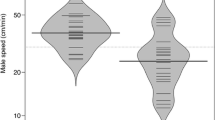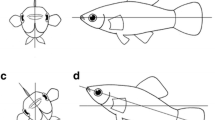Abstract
The mating system of Abdopus aculeatus incorporates sneaker matings, mate guarding, sex-specific body patterns, frequent copulations, and male–male competition for mates, making it more similar to that of aggregating decapod cephalopods than any previously known octopus social system. Large male–female A. aculeatus occupy ‘Adjacent’ (GA) dens and copulate frequently in mate-guarding situations over successive days. Nearby individuals copulate in ‘Temporary guarding’ (GT) and ‘Transient’ (T; non-guarding) situations, the latter of which can involve ‘Sneaker’ (S) mating. In a focal animal study of these octopuses in the wild (Sulawesi, Indonesia) we addressed the hypotheses that they demonstrate: (1) precopulatory mate choice, (2) differential copulation rates by individuals employing different mating tactics, and (3) distant sex identification. We quantified daily copulation rates of A. aculeatus of reproductive size as well as aspects of copulation duration, display, mate-competition, and mate rejection. Mating tactic correlated with daily copulation rates. ♂GA spent significantly more time copulating than did ♂T, while ♀GA spent more than twice as much time per day in copula than did other females. Sneaker copulations lasted longer than those by males adopting other tactics. Mate-guarding was an effective and important tactic used by males to temporarily monopolize mating with apparently non-selective females. Males demonstrated clear pre-copulatory mate choice by guarding and mating repeatedly with large females (typically ♀GA). While foraging alone away from the den, ♂G procured ‘Transient’ copulations with unguarded females. However, mate-guarding reduced the amount of time ♂G were alone and may impede their ability to seek out new mates. Low-copulation rates by ♀T, the smallest female tactic on average, may reflect this trade-off between mate preference and mate-searching by males, or non-receptivity of some females. A male-typical body pattern (black and white stripes) appeared to facilitate distant sex identification. Although mating and aggression were often initiated before contact between individuals, same-sex copulations and intense male–female aggression were rare. By contrast frequent male–female copulations and intense male–male aggression were consistent behavioral components of mating in A. aculeatus at these sites. Because the behavioral and ecological characters conducive to this complex system are not exclusive to A. aculeatus, it is possible that other octopuses exhibit some or all of these behaviors.


Similar content being viewed by others
References
Adamo SA (1999) Field observations of schooling in the oval squid, Sepioteuthis lessoniana (Lesson, 1830) J Moll Stud 65:377–380
Andersson M (1994) Sexual selection. Princeton University Press, Princeton, New Jersey
Aronson RB (1989) The ecology of Octopus briareus Robson in a Bahamian saltwater lake. Am Malacol Bull 7:47–56
Bland JM, Altman DG (1995) Multiple significance tests: the Bonferroni method. Br Med J 310:170
Boal JG (2006) Social recognition: a top down view of cephalopod behavior. Vie Milieu 56:69–79
Bonduriansky R (2001) The evolution of male mate choice in insects: a synthesis of ideas and evidence. Biol Rev 76:305–339
Cheng MAW (1996) The reproductive biology of two species of pygmy octopuses Hapalochlaena lunulata and Octopus bocki. PhD Dissertation, Berkeley, California
Cheng MW, Caldwell RL (2000) Sex identification and mating in the blue-ringed octopus, Hapalochlaena lunulata. Anim Behav 60:27–33
Cigliano JA (1995) Assessment of the mating history of female pygmy octopuses and a possible sperm competition mechanism. Anim Behav 49:849–851
Corner BD, Moore HT (1980) Field observations on the reproductive behavior of Sepia latimanus. Micronesica 16:235–260
Cortez T, Gonzalez AF, Guerra A (1999) Growth of Octopus mimus (Cephalopoda, Octopodidae) in wild populations. Fish Res 42:31–39
Di Cristo C, Van Minnen J, Di Cosmo A (2005) The presence of APGWamide in Octopus vulgaris: a possible role in the reproductive behavior. Peptides (New York) 26:53–62
Gowaty PA (1996) Battles of the sexes and origins of monogamy. In: Black JM (ed) Oxford ornithology series; partnerships in birds: the study of monogamy. Oxford University Press, Oxford, pp 21–52
Guzik MT, Norman MD, Crozier RH (2005) Molecular phylogeny of the benthic shallow-water octopuses (Cephalopoda: Octopodinae). Mol Phylo Evol 37:235–248
Hall KC, Hanlon RT (2002) Principal features of the mating system of a large spawning aggregation of the giant Australian cuttlefish Sepia apama (Mollusca: Cephalopoda). Mar Biol 140:533–545
Hanlon RT, Messenger JB (1996) Cephalopod behaviour. Cambridge University Press, Cambridge
Hartwick B (1983) Octopus dofleini. In: Boyle PR (ed) Cephalopod life cycles. Academic Press, London, pp 277–291
Huffard CL (2005) The behavioral ecology and locomotion of Abdopus aculeatus (d’Orbigny, 1834). PhD, Berkeley, California
Huffard CL (2007) Ethogram of Abdopus aculeatus (Cephalopoda: Octopodidae): can behavioural characters inform octopodid taxonomy and systematics? J Molluscan Stud 73:185–193
Hochner B, Shomrat T, Fiorito G (2006) The octopus: a model for a comparative analysis of the evolution and memory mechanisms. Biol Bull 210:308–317
Iribarne OO (1991) Life history and distribution of the small South-Western Atlantic octopus Octopus tehuelchus. J Zool 223:549–566
Jantzen TM, Havenhand JN (2003) Reproductive behavior in the squid Sepioteuthis australis from South Australia: interactions on the spawning grounds. Biol Bull 204:305–317
Joll LM (1976) Mating, egg laying and hatching of Octopus tetricus (Mollusca: Cephalopoda) in the laboratory. Mar Biol 36:327–333
Jormalainen V (1998) Precopulatory mate guarding in crustaceans: male competitive strategy and intersexual conflict. Q Rev Biol 73:275–304
Krebs JR, Davies NB (1993) An introduction to behavioural ecology. Blackwell, Oxford
Mather JA (1978) Mating behavior of Octopus joubini. Veliger 21:265–267
Norman MD (1992) Octopus cyanea Gray 1849 (Mollusca: Cephalopoda) in Australian waters: description and taxonomy. Bull Mar Sci 49:20–38
Norman MD, Finn J (2001) Revision of the Octopus horridus species-group, including erection of a new subgenus and description of two member species from the Great Barrier Reef, Australia. Invertebr Taxon 15:13–35
Parker GA (1990) Sperm competition games: sneaks and extra-pair copulations. Proc R Soc Biol Sci B 242:127–133
Parker GA (1998) Sperm competition and the evolution of ejaculates: towards a theory base. In: Birkhead TR, Moller AP (eds) Sperm competition and sexual selection. Academic Press, San Diego, pp 3–54
Sauer WHH, Smale MJ, Lipinski MR (1992) The location of spawning grounds, spawning and schooling behaviour of the squid Loligo vulgaris reynaudii (Cephalopoda: Myopsida) off the Eastern Cape Coast, South Africa. Mar Biol 114:97–107
Semmens JM, Pecl GT, Villanueva R, Jouffre D, Sobrino I, Wood JB, Rigby PR (2004) Understanding octopus growth: patterns, variability and physiology. Mar Fresh Res 55:367–377
Siegel S, Castellan JNJ (1988) Nonparametric statistics for the behavioral sciences. McGraw-Hill, New York
Thompson JT, Voight JR (2003) Erectile tissue in an invertebrate animal: the octopus copulatory organ. J Zool 261:101–108
Tinbergen N (1953) Social behaviour in animals. Methuen, London
Tsuchiya K, Uzu T (1997) Sneaker male in octopus. Venus Jpn J Malac 56:177–181
Van Heukelem WF (1983) Octopus cyanea. In: Boyle PR (ed) Cephalopod life cycles. Academic Press, London, pp 267–276
Voight JR (1991) Ligula length and courtship in Octopus digueti a potential mechanism of mate choice. Evolution 45:1726–1730
Voight JR (1992) Movement, injuries and growth of members of a natural population of the Pacific pygmy octopus, Octopus digueti. J Zool 228:247–263
Ward LA (1998) Octopus brachiomatus sp. nov. (Cephalopoda: Octopodidae), a new shallow-water, arm-autotomizing octopus from Guam; and arm autotomy in Octopus brachiotomus from Guam. MS Thesis, University of Guam (unpublished)
Wells MJ, Wells J (1972) Sexual displays and mating of Octopus vulgaris and Octopus cyanea and attempts to alter performance by manipulating the glandular condition of the animals. Anim Behav 20:293–308
Wiley RH, Poston J (1996) Indirect mate choice, competition for mates, and coevolution of the sexes. Evolution 50:1371–1381
Williamson R, Chrachri A (2004) Cephalopod neural networks. Neurosignals 13:87–98
Yarnall JL (1969) Aspects of the behavior of Octopus cyanea. Anim Behav 17:747–754
Young JZ (1962) Courtship and mating by a coral reef octopus (O. horridus). Proc Zool Soc Lond 138:157–162
Young JZ (1971) The anatomy of the nervous system. Clarendon Press, Oxford
Acknowledgments
We thank the Indonesian Institute of Sciences (LIPI) for granting permission to conduct this work. Financial support was provided by the Beim Endowment for Field Research, Sigma Xi, University of California, the Western Society of Malacologists, and the American Malacological Society grants to CLH. Dr. Helen Fox provided airfare to Indonesia on several occasions, and Operation Wallacea supported fieldwork in Southeast Sulawesi. Michael Caldwell, Heather Spalding, Brendan Hever, and Operation Wallacea participants volunteered their assistance in the water. Dr. Mark Erdmann, Arnaz Mehta, and Tanta Ita kindly provided support, entertainment, and language training to CLH. Four anonymous reviewers helpfully reviewed the final draft of this manuscript. This research complies with all current laws in Indonesia and the USA.
Author information
Authors and Affiliations
Corresponding author
Additional information
Communicated by P. Kraufvelin.
Electronic supplementary material
Below is the link to the electronic supplementary material.
227_2008_930_MOESM1_ESM.mpg
Video S1: Abdopus aculeatus mating in the wild. Note 1) ‘BWS’ 21 body pattern on the side of the male facing the ochre female, 2) white hectocotylus extending 22 from male (left) to female (right), and 3) attempt by female to catch prey in her web (MPG 1306 kb)
227_2008_930_MOESM2_ESM.mpg
Video S2: Abdopus aculeatus mating in the wild. Note 1) ‘BWS’ 15 body pattern on the side of the male facing the ochre female, 2) white hectocotylus extending 16 from male (left) to female (right) stretched nearly than twice its resting length, and 3) small 17 trevaly (Caranx sp.) and cigar wrasse (Chelio inermis) near pair (MPG 676 kb)
Rights and permissions
About this article
Cite this article
Huffard, C.L., Caldwell, R.L. & Boneka, F. Mating behavior of Abdopus aculeatus (d’Orbigny 1834) (Cephalopoda: Octopodidae) in the wild. Mar Biol 154, 353–362 (2008). https://doi.org/10.1007/s00227-008-0930-2
Received:
Accepted:
Published:
Issue Date:
DOI: https://doi.org/10.1007/s00227-008-0930-2




